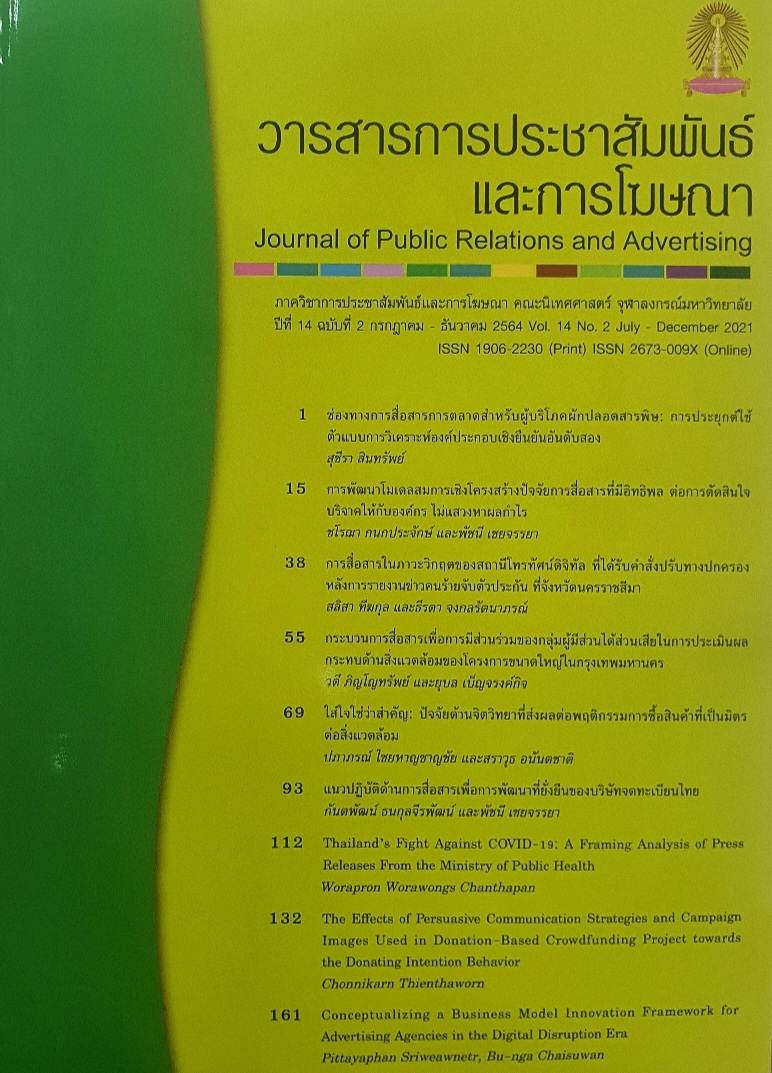Structural Equation Model Development of Communication Factors Influencing Donation to Non-Profit Organization
Main Article Content
Abstract
The objectives of this research were 1) to develop a structural equation model of communication factors influencing donation to non-profit organization 2) to examine the goodness of fit the structural model of communication factors influencing donation to non-profit organization with the empirical data. This research was a quantitative research employing the survey method. Data were gathered by questionnaire and the research sample consisted of 315 donators of 3 organizations which are 1) UNICEF Thailand 2) Ramathibodi Foundation 3) The Thai Red Cross Society. Data were analyzed with the structural equation modeling (SEM). The results revealed that the structural model of communication factors influencing donation to non-profit organization developed in this research fitted with the empirical data at the statistical significance level of 0.01, 0.05, and 0.001. Also, the results of path analysis of variables in this model revealed that communication factor had direct effect on trust with a path coefficient of 0.24. Social marketing had direct effect on trust with a path coefficient of 0.23. Corporate image had direct effect on trust, donation motivation and had direct effect on donation behavior with path coefficients of 0.40, 0.18 and 0.38 respectively. Finally, trust had direct effect on donation motivation and had direct effect on donation behavior with path coefficients of 0.42 and 0.26.
Article Details
References
กนกศักดิ์ แก้วเทพ. (2552). มรรควิธีเศรษฐศาสตร์การเมือง (3) : เศรษฐศาสตร์แห่งการให้ (พิมพ์ครั้งที่ 1). กรุงเทพมหานคร: จุฬาลงกรณ์มหาวิทยาลัย.
ณัชชา จำรูญจันทร์. (2552). เศรษฐศาสตร์ว่าด้วยการบริจาคโลหิตซ้ำ. (วิทยานิพนธ์ปริญญามหาบัณฑิต), มหาวิทยาลัยธรรมศาสตร์, กรุงเทพมหานคร.
ณัฏชนน ไพรรุณ. (2560). ประสิทธิภาพการระดมทุนขององค์กรไม่แสวงหาผลกำไร กรณีองค์กรศาสนาในประเทศไทย. (วิทยานิพนธ์ปริญญามหาบัณฑิต), สถาบันบัณฑิตพัฒนบริหารศาสตร์, กรุงเทพมหานคร.
ทวีป ลิมปกรณ์วณิช. (2547). กลยุทธ์การสื่อสารเพื่อโน้มน้าวใจบุคคลให้มาบริจาคอวัยวะ. (วิทยานิพนธ์ปริญญามหาบัณฑิต), จุฬาลงกรณ์มหาวิทยาลัย, กรุงเทพมหานคร.
ธงชัย สันติวงษ์ และชนาธิป สันติวงษ์. (2542). องค์การกับการสื่อสาร (พิมพ์ครั้งที่1.). กรุงเทพมหานคร: โรงพิมพ์มหาวิทยาลัยธรรมศาสตร์.
ธนัญญา ประภาสะโนบล. (2527). การวางแผนการประชาสัมพันธ์และการจัดแถลงข่าว เอกสารการสอนชุดวิชา วส.357 การประชาสัมพันธ์ 2 กรุงเทพมหานคร: มหาวิทยาลัยธรรมศาสตร์.
พรพรรณ ชมงาม. (2552). ปัจจัยการสื่อสารที่มีผลต่อการตัดสินใจบริจาคอวัยวะของประชาชนในเขตกรุงเทพมหานคร. (วิทยานิพนธ์ปริญญามหาบัณฑิต), มหาวิทยาลัยธรรมศาสตร์, กรุงเทพมหานคร.
พระเกียรติพงษ์ มณีวรรณ. (2554). ปัจจัยที่มีอิทธิพลต่อการบริจาคเงินทำบุญในวัดบ้านมอญ (ต้นโพธิ์แฝด) ตำบลสันกลาง อำเภอสันกำแพง จังหวัดเชียงใหม่. (วิทยานิพนธ์ปริญญามหาบัณฑิต), มหาวิทยาลัยเชียงใหม่, เชียงใหม่.
พระครูโพธิชยธรรม. (2555). การศึกษาเปรียบเทียบการให้ทานสมัยพุทธกาลกับการให้ทานของชาวตำบลนาเลิง อำเภอ
เสลภูมิ จังหวัดร้อยเอ็ด. วันที่เข้าถึงข้อมูล 20 กรกฎาคม 2563 แหล่งที่มา http://www.mcu.ac.th/userfiles/file/thesis/Buddhist-Studies/2555_Buddhist-Stuies/55-02-2-011.pdf
พิริยะ ผลพิรุฬห์. (2557). การจัดการองค์กรไม่แสวงหาผลกำไร (Nonprofit Management) เพื่อการพัฒนาประเทศไทย. วันที่เข้าถึงข้อมูล 20 กรกฎาคม 2563 แหล่งที่มา http://piriya-pholphirul.blogspot.com/2014/04/nonprofit-management.html
มาลินี วงษ์สิทธิ์. (2535). ทัศนคติต่อค่านิยมเกี่ยวกับครอบครัวในสังคมไทย. กรุงเทพมหานคร: สถาบันประชากรศาสตร์ จุฬาลงกรณ์มหาวิทยาลัย.
ยุทธ ไกยวรรณ์. (2556). การวิเคราะห์โมเดลสมการโครงสร้างด้วย AMOS. กรุงเทพมหานคร: สำนักพิมพ์แห่ง จุฬาลงกรณ์มหาวิทยาลัย.
ระบบสถิติทางการทะเบียน. (2560). สถิติประชากรและบ้าน - จำนวนประชากรแยกรายอายุ. วันที่เข้าถึงข้อมูล 20 กรกฎาคม 2563 แหล่งที่มา http://stat.dopa.go.th/stat/statnew/upstat_age.php
วรภัทร์ สังข์น้อย. (2541). ปัจจัยที่มีผลต่อการตัดสินใจบริจาคอวัยวะของญาติผู้เสียชีวิต. (วิทยานิพนธ์ปริญญา มหาบัณฑิต), จุฬาลงกรณ์มหาวิทยาลัย, กรุงเทพมหานคร.
วรรณา พูลเกื้อ. (2546). การออกแบบงานโฆษณาเพื่อกระตุ้นให้เกิดการบริจาคของมูลนิธิเด็ก. (วิทยานิพนธ์ปริญญามหาบัณฑิต), มหาวิทยาลัยศิลปากร, กรุงเทพมหานคร.
วศมล สบายวัน. (2553). การพัฒนาแบบวัดภาพลักษณ์องค์กร. (วิทยานิพนธ์ปริญญามหาบัณฑิต), จุฬาลงกรณ์มหาวิทยาลัย, กรุงเทพฯ.
ศุกลิน วนาเกษมสันต์. (2552). การสร้างแบบสอบถามวัดภาพลักษณ์องค์กร. (วิทยานิพนธ์ปริญญามหาบัณฑิต), มหาวิทยาลัยธรรมศาสตร์, กรุงเทพฯ.
สถาบันวิจัยสังคม จุฬาลงกรณ์มหาวิทยาลัย. (2546). องค์กรสาธารณประโยชน์ในประเทศไทย. กรุงเทพฯ: สถาบันวิจัยสังคม จุฬาลงกรณ์มหาวิทยาลัย.
สำนักงานสถิติแห่งชาติ. (2556). จำนวนองค์กรไม่แสวงหาผลกำไรและการเปลี่ยนแปลงระหว่างปี พ.ศ. 2550 และปี พ.ศ.2556 จำแนกตามภูมิภาค. วันที่เข้าถึงข้อมูล 20 กรกฎาคม 2563 แหล่งที่มา http://service.nso.go.th/nso/web/survey/surbus4-6-4.html
เสถียร เชยประทับ. (2528). การสื่อสารและการพัฒนา. กรุงเทพมหานคร: เจ้าพระยาการพิมพ์.
อรวรรณ ปิลันธน์โอวาท. (2537). การสื่อสารเพื่อการโน้มน้าวใจ. กรุงเทพมหานคร: สำนักพิมพ์จุฬาลงกรณ์มหาวิทยาลัย.
อรุณี ศุภนาม. (2539). ความรู้ ทัศนคติ และพฤติกรรมเกี่ยวกับการบริจาคโลหิตของเยาวชนจากสถาบันการศึกษาในเขตกรุงเทพมหานคร. (วิทยานิพนธ์ปริญญามหาบัณฑิต), จุฬาลงกรณ์มหาวิทยาลัย, กรุงเทพมหานคร.
อุทุมพร นำเจริญวุฒิ. (2553). การเปิดรับข่าวสาร ความรู้ ทัศนคติและการมีส่วนร่วมในกิจกรรมการบริจาคเลือดสุนัข. (วิทยานิพนธ์ปริญญามหาบัณฑิต), จุฬาลงกรณ์มหาวิทยาลัย, กรุงเทพมหานคร.
Bagozzi, R. P. (2000). On the Concept of Intentional Social Action in Consumer Behavior. Journal of Consumer Research, 27, 388-396.
Becker, L. E., & McComb, M. E. (1979). Using mass communication theory. Englewood Cliffs: Prentice-Hall.
Bettinghaus, E. P. (1980). Persuasive Communication. New York: Holt,Rinehart and Winston,Inc.
Gagic, S., & Leuhusen, C. (2013). Communicating for donations - Do you give with the heart or with the brain? (Master 's thesis), Linköping University, Linköping
Hair, J. F. (2010). Multivariate data analysis (7 ed.). New Jersey: Pearson Prentice Hall.
Hovland, C. I., Janis, I. L., & Kelly, H. H. (1953). Communication and Persuation. New Haven: Yale University Press.
Hyunjung, K. (2018). The Media Factor Influencing the Effect of Organ Donation Advocacy in South Korea. The Social Science Journal, 35(4).
Johnson, H. M. (1970). Sociology: A Systematic Introduction. New Dellhi: Allied Publisher Private.
Kachonnarongvanish, P. (2017). Thai Merit Making Behavior and Its Implication on Communication Plan for NPOs. (Master's thesis), Thammasat university, Bangkok.
Kotler, P., & Armstrong, G. (1999). Principles of Marketing (8 ed.): Prentice Hall.
Kotler, P., & Roberto, E. L. (1989). Social Marketing: Strategies for Changing Public Behavior. New York: Free Press.
Kotler, P., & Zaltman, G. (1971). Social Marketing: An Approach to Planed Social Change. Journal of Marketing, 35, 3-12.
Lindahl, E. W. (2010). Principles of fundraising: Theory and practice. London: Jones and Barlett Publishers.
Lovell, R. B. (1980). Adult Learning. New York: Halsted Press Wiley & Son.
MacMillan, K., Money, K., Money, A., & Downing, S. (2005). Relationship marketing in the not-for-profit sector: an extension and application of the commitment–trust theory. Journal of Business Research, 58(6), 806-818.
Mixer, R. M. (1993). Principles of professional fundraising: useful foundations for successful practice. San Francisco: Jossey-Bass.
Morgan, R. M., & Hunt, S. D. (1994). The Commitment–Trust Theory of Relationship Marketing. Journal of Marketing, 58(3), 20-38.
Rogers, E. M., & Shoemaker, F. F. (1971). Communication of Innovation A Cross-Cultural Approach (2 ed.). New York: The Free Press.
Rune, P. (2002). Information Design: An Introduction: John Benjamins Publishing.
Venable, B. T., Rose, G. M., Bush, V. D., & Gilbert, F. W. (2005). The Role of Brand Personality in Charitable Giving: An Assessment and Validation. Journal of the Academy of Marketing Science, 33(3), 295-312.
Weinreich, N. K. (1999). Hand-ons social marketing: A step-by-step guide. California: Sage Publications.


